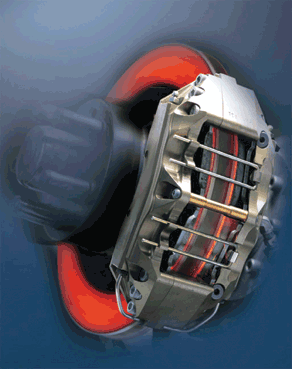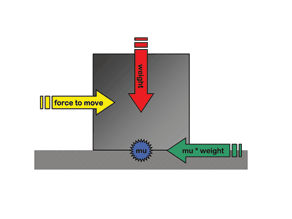If there’s just one piece of information you should retain after reading this book, it’s that the brakes don’t stop the car. Contrary to popular belief, bright red calipers, cross-drilled rotors, and stainless steel brake hoses are not responsible for vehicle deceleration.

Regardless of their color, size, number of pistons, slots, holes, or sex appeal, the brakes don’t stop the car. As you’ll learn, they exist solely to convert energy from one form into another. A glowing rotor is a sure sign that the energy conversion process is in high gear. (Hawk Performance)
That’s a pretty hard statement to accept, isn’t it? This fundamental concept directly contradicts your own everyday driving experiences. You push on the brake pedal hundreds of thousands of times per year, each time expecting your vehicle to slow down. This is repeated more than one million times over the life of a typical vehicle. You’re probably asking yourself right now, “How can those countless observations be wrong?”
Thankfully, the true purpose of brake systems is not based on particle string theory or quantum mechanics. All you need is solid understanding of the First Law of Thermodynamics and the rest will fall into place.
The Conservation of Energy
The First Law of Thermodynamics says that energy (the ability to do work) can neither be created nor destroyed. In other words, the amount of energy found in the universe is constant, and regardless of what you choose to do with it, you can’t change the total amount.
(Note here that Albert Einstein later proved that isn’t necessarily the case, but exceptions only occur when traveling at the speed of light. Since the vehicles you drive are most certainly not traveling at the speed of light, you can ignore Einstein’s accurate but irrelevant observations without worry.)
While the law as stated refers to the universe as a whole, the focus of automotive enthusiasts is quite a bit narrower. From this perspective, the universe can be replaced with the vehicle and the law still holds true.
In summary, the amount of energy in and around your vehicle is constant, and while you can’t change the total amount, you can influence which forms that energy takes.

These vehicles are sitting on the grid, ready to head out on the track. Even if they all were to attain the same top speed on the main straight, they would all have different amounts of kinetic energy because of their differences in weight. (Wayne Flynn/pdxsports.com)
Where Energy Comes From
The primary source of energy in most vehicles comes from the chemical energy stored in the bonds holding together molecules of gasoline in the gas tank. The internal combustion engine is a device which takes this stored chemical energy and converts it into a variety of other energy forms with the intended effect of accelerating the vehicle to a given speed and maintaining that speed as long as the driver intends—or until the gas tank is empty.
In this regard, the most useful form of energy coming from the internal combustion engine is kinetic energy—the energy of the vehicle in motion. Unfortunately, this only accounts for about 25 to 35 percent of the total energy stored in the fuel. The remaining 65 to 75 percent is converted into relatively useless thermal energy (such as heat) lost to the cooling system and stored in the exhaust gasses.

While complex in design and operation, the internal combustion engine only exists to convert the stored chemical energy of gasoline into vehicle kinetic energy. The higher the rate of energy conversion, the more power (and acceleration) the vehicle is capable of producing. Turbochargers certainly add to the excitement. (Randall Shafer)
Friction
Since friction is discussed at great length in this book, it makes sense to define it now. In simple terms, friction is the resistance to movement that occurs between any two objects that are in contact with one another. More specifically, any time you attempt to generate relative motion between two objects, there will be a force generated which resists the motion you are trying to achieve. This force is called the frictional force.
The simplest example is a block of wood sitting on a table. In order to move the block along the surface of the table, you need to push it with a certain amount of force. The force required to get the block to move is equal to the weight of the block multiplied by the amount of friction, or resistance, found between the block and the table. This level of resistance is called the coefficient of friction. In equation form:
Force required to move the object (lb) = coefficient of friction (unitless)
x weight of the object (lb)

The force due to friction (green arrow) is equal to the coefficient of friction, or mu (blue star), multiplied by the object’s weight (red arrow). This is equal to the force required to move the object along the surface (yellow arrow). As a result, the lower the coefficient of friction, the easier the object will be to move.
From this relationship you can see that lower coefficients of friction result in lower forces required to move the block. For example, the block would be easier to push along a polished granite tabletop than along a piece of 60-grit sandpaper because the coefficient of friction is lower on the tabletop.
In addition, once these two objects are moving relative to each other there is an energy transformation at the interface. This is the frictional force at work. The most common form of energy transformation is converting kinetic energy into thermal energy. As a result, when the block slides along the table, both the block and the tabletop will increase in temperature because they absorb the heat generated due to friction.
Subsequent chapters explore some of the different ways friction is developed, but for now let it suffice to say that friction always makes the conversion to kinetic energy more difficult than it needs to be. Unfortunately though, like death and taxes, you just can’t escape from frictional forces.

Aerodynamic drag is just one mechanism that can convert a vehicle’s kinetic energy into heat. Although the contribution from aerodynamic drag is small while driving around town, it’s the only mechanism available for an airborne vehicle – hit the brakes if you want, but they won’t help you slow down! (Wayne Flynn/pdxsports.com)
Vehicle Kinetic Energy Comparison
The following table compares the total kinetic energy of six unique vehicles at four different speeds. Due to the nature of energy calculations, the units are given in foot-pounds. Since torque also is expressed in units of foot-pounds this can be a little confusing at first, but regardless of the units used, note the extreme differences in kinetic energy between the various conditions.
| 35 mph | 75 mph | 150 mph | 225 mph | |
| 200-lb soap box derby car | 8,194 | 37,625 | 150,502 | 338,629 |
| 400-lb race kart | 16,388 | 75,251 | 301,003 | 677,258 |
| 600-lb sport bike | 24,582 | 112,876 | 451,505 | 1,015,886 |
| 1,900-lb formula car | 77,843 | 357,441 | 1,429,766 | 3,216,973 |
| 3,000-lb passenger car | 122,910 | 564,381 | 2,257,525 | 5,079,431 |
| 80,000-lb tractor-trailer | 3,277,592 | 15,050,167 | 60,200,669 | 135,451,505 |
While not all of these vehicles are capable of reaching the speeds listed, the data allows for some interesting comparisons. For example, a 600-pound sport bike at 150 mph has less kinetic energy than a 1,900-pound formula car traveling at half that speed, while an 80,000-pound tractor-trailer traveling at just 35 mph has the same amount of kinetic energy as a 1,900-pound formula car traveling at over 225 mph!
